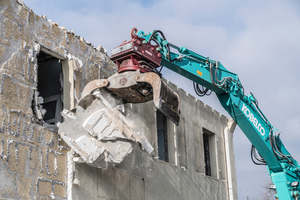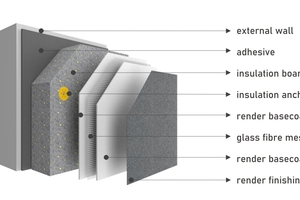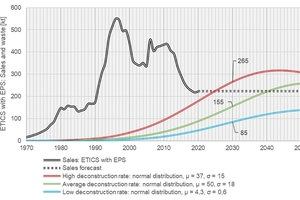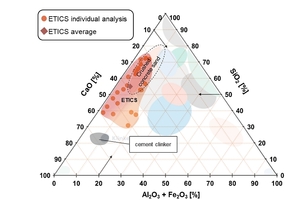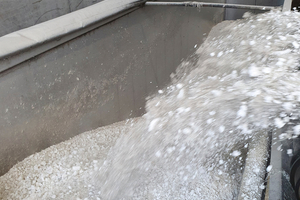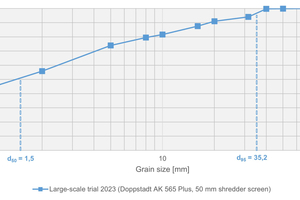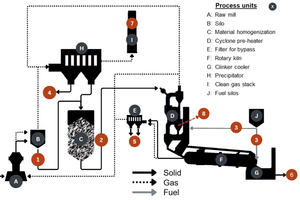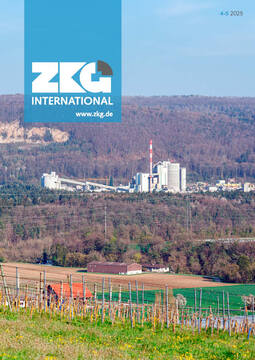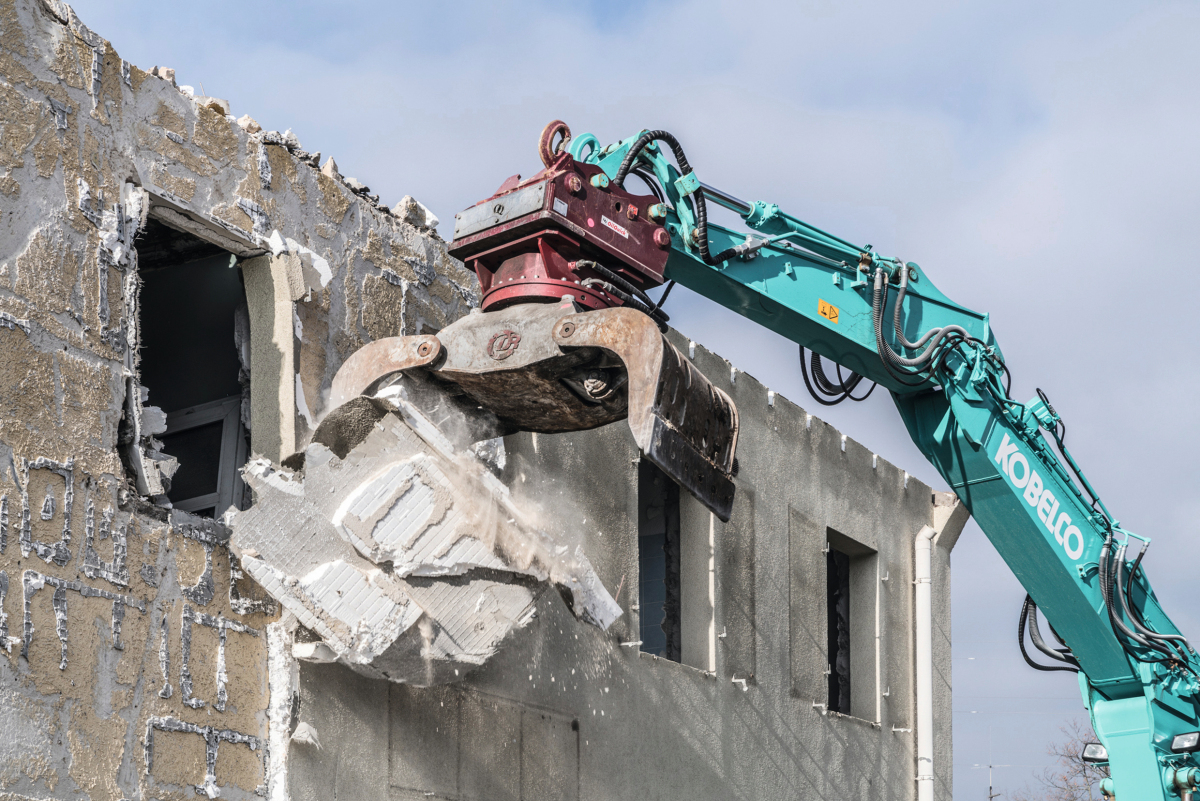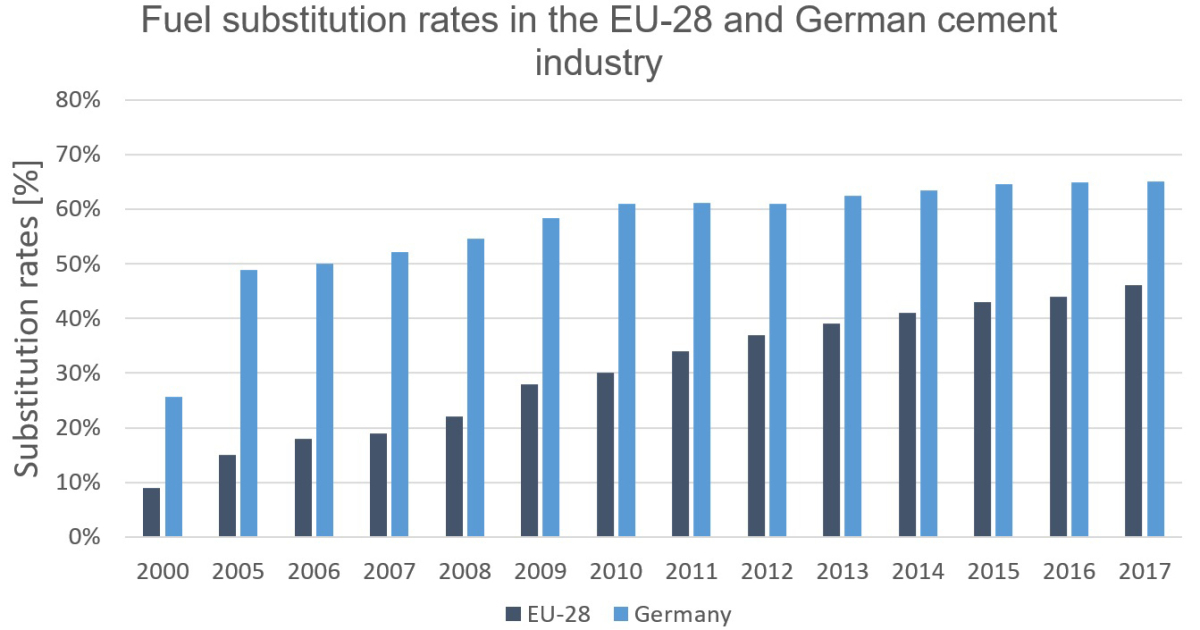Potentials of material and energy recovery of ETICS waste with EPS in the cement plant
A large-scale test has shown that ETICS waste with HBCD-containing EPS can be materially and energetically recovered under controlled conditions without negative effects on emissions, operation and clinker quality - a possible building block for a broader raw materials strategy.
1 Introduction
Against the background of the cement industry’s growing demand for alternative fuels and raw materials, the focus is shifting to the development of previously unused waste streams [1]. Waste from external thermal insulation composite systems (ETICS) with expanded polystyrene (EPS) has not yet been used in cement plants, but shows great potential for combined material and energy recovery. While the high-calorific EPS can be used to generate energy, the predominantly mineral plaster fraction can be incorporated into the clinker as a raw material substitute.
Despite this potential, ETICS waste is currently disposed of almost exclusively via waste incineration plants (WIPs), which are already working at full capacity and are not technically suitable for this material fraction. In view of the growing quantities of ETICS deconstruction waste and increasing requirements for high-quality recycling, ETICS recycling in the cement plant can help to relieve the burden on waste incineration plants and support a sustainable raw materials strategy for the cement industry.
In 2022, the first large-scale test for the material and energy recovery of low-HBCD ETICS waste was carried out in the cement plant. No effects on operation, emissions or product quality were found at an addition rate of approx. 1 wt.-% to the kiln meal [2]. Based on these results, an extended large-scale test with higher enriched material (HBCD content in ETICS > 500 mg/kg) followed in 2023 in order to comprehensively test the practical suitability of the recycling strategy [3]. This article presents the results of this large-scale test, including an overview of the composition and properties of ETICS waste as well as possible effects on plant operation, emissions and clinker quality. A particular focus is on the introduction of the brominated flame retardant HBCD via the EPS fraction and its behavior in the thermal process.
2 External thermal insulation composite systems
2.1 ETICS structure and predicted waste generation
ETICS consist of several mineral and non-mineral components that are used to insulate and finish the façades of old and new buildings (see Figure 1). Systems with expanded polystyrene (EPS) as an insulating material have a share of approx. 80% of the total stock installed to date [4]. Although the annual market share of systems with EPS has declined in recent years, it remains at a high level of around 50% [5].
Building products such as ETICS are generally very durable and only accumulate as waste decades after installation. As these waste volumes are not recorded separately in statistics, Heller [7] has forecast the current and future waste volumes based on waste statistics (see Figure 2).
The average deconstruction rate is considered to be the most realistic estimate. Renovation, modernization and deconstruction measures should result in around 120000 Mg of ETICS waste in 2025, assuming an average deconstruction activity. This amount of waste is expected to increase significantly in the coming years.
2.2 Current disposal situation
Although deconstruction rates are currently still low, the disposal of ETICS waste is already an increasing challenge. The bonding effect of the individual material components prevents separation by type during the dismantling process. To make matters worse, in the past EPS was treated with the brominated flame retardant HBCD. This has been listed as a persistent organic pollutant (POP) under the Stockholm Convention since 2013. In response to this classification, HBCD was replaced by the polymeric flame retardant Polymer-FR in the insulation boards from 2015 [8]. However, as many older ETICS systems contain HBCD, around 95% of them are currently disposed of via waste incineration plants [9], as this is one of the ways in which the HBCD contained can be completely destroyed [10].
However, in addition to insufficient resource efficiency, it should be noted that the high calorific value of EPS (approx. 38 MJ/kg) is unsuitable for use in waste incineration plants and that the high proportion of mineral components in ETICS leads to a significant increase in the ash content and the associated additional costs for waste incineration plant operators. In addition, waste incineration plants in Germany are currently working at full capacity in the medium to long term. New disposal routes must therefore be developed for the significantly increasing quantities of EPS-based ETICS to be disposed of in the future and appropriate framework conditions must be created so that they can be recycled as resource-efficiently as possible.
3 ETICS recycling in cement plants
One promising approach is the recycling of ETICS in cement plants via calciner firing, whereby the existing combustion conditions (dwell times > 2 s at over 850 °C) ensure HBCD destruction [11]. The aim of this recycling option is to recycle not only the EPS fraction (approx. 10 wt.%) energetically, but also the mineral fraction (approx. 90 wt.%) by incorporating it into the cement clinker. An assessment by Heller shows that this approach offers both ecological and economic advantages compared to the status quo (waste incineration plant) [7].
However, in order to ensure the reliable feeding of secondary materials via the calcinator and to meet approval requirements, specific requirements regarding the chemical composition and physical properties of the ETICS must first be met, which are described below.
3.1 Chemical composition of ETICS waste
The chemical composition of ETICS waste was assessed by analyzing the EPS and mineral fractions separately. As there are currently no legal limits for the recycling of secondary raw materials in Germany, the requirements of the Swiss Waste Ordinance (VVEA) [12] for the mineral fraction and plant-specific specifications for the EPS fraction were used for the two large-scale ETICS tests carried out by IWARU in consultation with the responsible approval authority.
An evaluation of around 20 samples of different origins shows that the ETICS waste tested complies with these limit values by clear margins (see Table 1). As the ETICS waste also has a predominantly lower heavy metal content compared to the secondary fuels normally used, no significant change in the heavy metal input in the cement production process is to be expected [3].
3.2 Mineral composition of ETICS waste
The mineral content of the ETICS waste remains as ash after incineration and passes into the clinker. Analyses show that this ash has a high content of clinker-typical main components such as CaO, SiO2, Al2O3 and Fe2O3 (see Table 2).
The three-material diagram shows that ETICS ash is chemically much closer to the typical clinker composition than many other alternative secondary materials (see Figure 3). Particularly in comparison to crushed concrete sand, which is considered a promising source of secondary raw materials, ETICS has a similar mineral composition, which underlines the potential of ETICS ash as a raw material substitute [13].
As ETICS waste has a lower lime standard compared to conventional raw meal mixtures, the quantity added must be carefully controlled. Tests show that up to 1 wt.% ETICS can be added without adjusting the raw material composition - depending on the composition of the available raw materials, a significantly higher addition is also possible without negatively affecting the lime standard or the clinker quality [14].
3.3 Requirements for the ETICS composition for feeding via the calciner
In the previous studies, a prepared ETICS mixture was delivered to a docking station via walking floor trailers and then pneumatically conveyed into the calciner. This procedure ensures a uniform material feed and prevents segregation of the brittle plaster fraction and the remaining ETICS material [2].
In the studies on processing, it was also found that crushing including metal separation with established processing units is sufficient and ensures the flyability of the material. Stressing the ETICS material by impact and shock using a high-speed shredder achieves the best effect, as this technique ensures the highest fineness of the material [14].
Due to the different elasticity of the individual components of the ETICS, selective shredding occurs during the preparation process. The brittle plaster fraction predominantly accumulates in the fine fraction (< 10 mm), while the elastic EPS is crushed to a lesser extent (< 30 mm) (see Figure 4). These properties have a positive effect on the necessary flying and blowing ability of the material [2].
For optimum reactivity (combustibility) and clinker quality, the material should be as fine-grained as possible (see Figure 5).
4 Large-scale test on the use of ETICS in the cement plant
The previous tests on the quality-assured use of ETICS in the cement plant were carried out at “Phoenix Zementwerke Krogbeumker GmbH & Co. KG” in Beckum/Germany. As this is a rotary kiln plant using the dry process with cyclone preheater that is widely used in Germany, it is likely that the following results can be transferred to a large number of German cement plants.
Building on the first large-scale test in 2022 [2], a further large-scale test lasting several days over a total period of 100 h was carried out in 2023. Over 60 Mg of ETICS waste containing HBCD (HBCD content > 500 mg/kg) was used continuously. The aim was to validate the practical suitability under real operating conditions and to comprehensively investigate possible effects on emissions and clinker quality [3]. In addition, a simplified bromine balance was drawn up on the basis of an input-output analysis in order to assess the potential effects of HBCD input on operation.
Overall, a raw material replacement of just over 1 wt.% was achieved with an ETICS share of approx. 1 wt.% in the kiln meal. The EPS fraction contributed approx. 1.7% to the calorific value and thus proportionally replaced primary fuels.
4.1 Results of the emission measurements
The emissions were monitored both internally by the cement plant operator and externally by the German Cement Works Association (VDZ). The scope of the emission measurements was based on the specifications for the annual individual measurements in accordance with the 17th BImSchV, but was expanded to include additional parameters (including aldehydes, HBCD, HBr & PCB) in agreement with the Münster district government.
In line with the results of the first large-scale test in 2022, the emission measurements showed no significant deviations from normal operation. Particular attention was paid to the bromine-specific emissions in the clean gas, among other things. During the use of ETICS containing HBCD, the concentrations of total bromine remained consistently below the limit of determination (LOD). The HBr values were well below the TA-Luft limit value of 3 mg/m³, with six out of ten individual measurements below the LOD of 0.04 mg/m³. The HBCD concentrations also remained below the LOD of < 0.04 ng/m³ in all measurements, which indicates complete destruction of the HBCD contained in the EPS.
With regard to possible by-products of brominated flame retardants - in particular brominated dioxins and furans (PBDD/F) - very low concentrations were also measured. No PBDD/F value exceeded the respective limit of quantification (< 0.07 ng/m³). The chlorinated dioxins and furans (PCDD/F) were consistently below 1% of the legal emission limit value of 0.1 ng/m³ in accordance with the 17th BImSchV. Overall, the results show that the use of ETICS containing HBCD has no effect on the emissions in the clean gas under these conditions.
4.2 Results of the investigations into clinker quality
The clinker samples produced in the large-scale test were analyzed comprehensively. The contents of the main oxides and the resulting clinker phases corresponded to the typical values of a Portland cement clinker and showed no differences to reference samples. Parameters such as silicate modulus, alumina modulus, the free lime content (free CaO) and degree of firing were also within the usual range and showed no abnormalities. The use of ETICS in the large-scale test therefore had no negative effects on the clinker quality [3].
4.3 Results of the bromine balance
Waste containing bromine, such as ETICS containing HBCD, can - like materials containing chloride - cause deposits and incrustations in cement plants and thus disrupt continuous operation. Despite these potential effects, the behavior of bromine in the cement production process has not yet been sufficiently researched. Against this background, bromine distribution was a central object of investigation. Therefore, all input and output streams of the process were systematically analyzed for their bromine content over the test period, both in standard operation (SO, without ETICS) and in test operation (TO, with HBCD-containing ETICS). The corresponding bromine loads were determined on this basis (see Table 3).
The simplified balance shows that bromine is predominantly introduced into the process via the raw materials used. The specific contribution of ETICS materials containing HBCD to the total bromine load was low and was of a similar order of magnitude to that from the other secondary fuels (SRF) used.
Overall, there is a balance gap, which indicates that a proportion of the bromine remains in the process cycle and a furnace or preheater cycle is formed.
The enrichment occurs - similar to the behavior of chlorine - primarily in the bypass dust. Compared to typical chlorine concentrations (predominantly around 5 wt.%), however, the bromine contents measured in the dusts in the ETICS large-scale test were significantly lower (0.01-0.1 wt.%). Therefore, no operational adjustments are necessary under comparable conditions [3]. A comparable bromine behavior was already determined in 1974 by Berry [17] during the thermal utilization of used oils containing bromine in a similarly configured cement plant, which additionally supports the plausibility of the present test results.
5 Summary and outlook
The large-scale test confirmed that quality-assured ETICS waste with HBCD-containing EPS can be used with EPS under controlled conditions in the cement plant for material and energy recovery - without negative effects on operation, emissions or clinker quality. The material analyses also show that the heavy metal content of ETICS waste is generally within the range or significantly below that of established secondary fuels.
Despite these positive results, Germany still lacks a clear legal framework for the material recovery of waste in cement plants - this includes ETICS as well as other potentially suitable substitute raw materials. The Swiss Waste Ordinance (VVEA) [12], which sets out specific requirements for the material recovery of waste in clinker production, could provide guidance. Transferring comparable regulations such as those in the NRW guidelines on energy recovery from waste in cement, lime and power plants [18] to the materials sector could simplify approval procedures and increase legal certainty for operators.
A look at the current recycling figures shows: While the replacement of fossil fuels in German cement plants is already well advanced at over 70%, the proportion of secondary raw materials in clinker is still at a comparatively low level of around 3.5 wt.-% on average [1]. Simplified approval procedures and clear regulations could help to significantly increase this proportion.
ETICS waste with EPS could make a relevant contribution here: by setting up a nationwide network of processing facilities and suitable cement plants, it seems possible in the future to recycle the entire expected volume of ETICS in terms of materials and energy [3].
6 Acknowledgements
The authors would like to thank the following partners for their technical and practical support during the large-scale test:
BASF SE, Doppstadt Umwelttechnik GmbH, ECOWEST Entsorgungsverbund Westfalen GmbH, Phoenix Zementwerke Krogbeumker GmbH & Co. KG and Sto SE & Co. KGaA.

